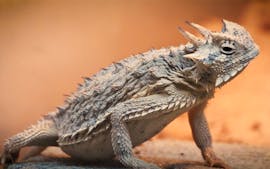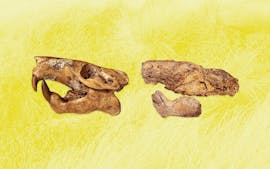In the April issue, senior editor Nate Blakeslee discusses Texas Parks and Wildlife’s program to reintroduce bighorn sheep to the mountains of far West Texas, examines how it could be a lucrative development for ranchers, and explores the repercussions that the program has had for other animals in the region, such as burros, elk, and mountain lions. Here’s the story behind the story.
What drew you to writing about the reintroduction of bighorn sheep to west Texas?
Most stories about wildlife focus on science—how do we keep fish healthy, control deer populations, etc.—but the bighorn story offered a chance to write about the politics of wildlife management, an important angle that is seldom covered. I was fascinated by the idea that an animal needs a constituency to look after its interests—just as, for example, a bill introduced in the legislature must have a champion to shepherd it through the political process. In this case, the bighorn sheep had a well-organized constituency, and the burro did not—or at least didn’t seem to—which made all the difference when state parks officials found themselves choosing between the two species. After Parks and Wildlife began shooting burros, however, they realized that in fact there was a constituency pulling for them, too. I’m not suggesting that science doesn’t play a role in wildlife management decisions, I’m just pointing out that politics is equally important. And that isn’t necessarily a criticism: politics informs everything that we do in the world of public policy.
What about the mountain lions?
I think it remains to be seen whether or not lions have a champion in Texas. Unlike the burro killings, the fact that lions are being destroyed in conjunction with the bighorn program is not widely known. It will be interesting to see what the reaction to this new piece of information will be. A mountain lion is an amazing animal—they can jump 18 feet straight up and range over hundreds of miles—but few people will ever see one because they are so reclusive. This is an important point. You can’t go on a safari to spot one, because they don’t lie around on a plain as African lions do. They will never be a tourist attraction, in other words. I think part of the reason wolves are so celebrated in Yellowstone is that park visitors have a decent chance of actually spotting them, especially if they visit in winter. Like the wolf, the lion’s role in maintaining healthy ecosystems is essential, but this may not be enough to win them a spot in the hearts and minds of Texans.
A lot of the controversy in this story revolves around whether a given animal—for example, elk, burros, and aoudads—belongs in a habitat. Why is this such a contentious point?
Part of the problem seems to be that we use terms such as “native” and “non-native” without having a common understanding of precisely what those terms mean. If wild burros and horses have been in the American west for five hundred years, does that make them native? Most biologists would say no, because they were brought here by humans. (Spanish explorers brought them.) But horses actually evolved right here in North America over millions of years, and modern horses were still here until about 10,000 to 12,000 years ago, when they died out. (Fortunately they had spread across the Bering land bridge to Asia before this happened.) If you want to argue that horses don’t belong in the American wilderness, in other words, you have to say that 10,000 years is too long to be gone, but 500 years is not enough time to be back. Each of those numbers is a blink of an eye in evolutionary time.
Even if we agree that horses belong, where does that leave burros, which are members of the same genus and share the same evolutionary roots? (You remember your high school biology: the classification chart goes kingdom, phylum, class, order, family, genus, and species.) If being the same genus doesn’t “count,”—if, that is, a reintroduced animal has to be the same species that was once present—then what about the question of sub-species? As I reported in the story, there are many different sub-species of bighorn, and the type being reintroduced to Big Bend are mostly different from the type historically found there. Does it matter? Who gets to decide?
Another problem is that it can be difficult to definitively establish the historic range of an animal, such as the elk or the bighorn, if it has been gone from a region for over a very long time. Debates about whether an animal was ever present in a given area can hinge on accounts recorded by seventeenth century explorers, or even on prehistoric cave paintings. Trying to determine whether a painting done thousands of years ago is of a mule deer or an elk does not sound like a very scientific process, but sometimes this is all researchers have to go on. That makes definitive answers elusive and subject to the push and pull of the public policy arena.
Is the bighorn program being driven by hunting interests?
The short answer to that is yes, in large part. Parks and Wildlife’s bighorn program has been generously supported over the years by a hunting and conservation group called the Texas Bighorn Society, which essentially kick-started the effort thirty years ago. It would be easy to caricature the bighorn program by saying the idea is to kill mountain lions before they kill bighorns so that hunters can kill bighorns themselves. That is a little too simple—after a decades-long effort to reintroduce the sheep, the last thing any hunting group or state agency wants to do is allow the animals to be hunted into oblivion again. And it is also true that in a state that is 97 percent privately owned, Parks and Wildlife has no choice but to work with private landowners to achieve its conservation goals, which inevitably means making concessions to the trophy hunting economy in some fashion. On the other hand, there is no denying that tax dollars are being used to kill lions for doing what lions were put on this earth to do. This is true not only in Big Bend, but in west Texas generally, where ranchers can call on a government agency known as Texas Wildlife Services to trap lions that are preying not only on livestock, but also those that are preying on game animals, such as deer or bighorn sheep, that happen to live on the same ranches. To some people, this type of activity blurs the line between wild animals, which under Texas law belong to everybody (or to nobody, if you prefer), and livestock—and between a commercial ranching operation and wilderness.







